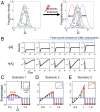Robust, linear correlations between growth rates and β-lactam-mediated lysis rates
- PMID: 29610312
- PMCID: PMC5910845
- DOI: 10.1073/pnas.1719504115
Robust, linear correlations between growth rates and β-lactam-mediated lysis rates
Abstract
It is widely acknowledged that faster-growing bacteria are killed faster by β-lactam antibiotics. This notion serves as the foundation for the concept of bacterial persistence: dormant bacterial cells that do not grow are phenotypically tolerant against β-lactam treatment. Such correlation has often been invoked in the mathematical modeling of bacterial responses to antibiotics. Due to the lack of thorough quantification, however, it is unclear whether and to what extent the bacterial growth rate can predict the lysis rate upon β-lactam treatment under diverse conditions. Enabled by experimental automation, here we measured >1,000 growth/killing curves for eight combinations of antibiotics and bacterial species and strains, including clinical isolates of bacterial pathogens. We found that the lysis rate of a bacterial population linearly depends on the instantaneous growth rate of the population, regardless of how the latter is modulated. We further demonstrate that this predictive power at the population level can be explained by accounting for bacterial responses to the antibiotic treatment by single cells. This linear dependence of the lysis rate on the growth rate represents a dynamic signature associated with each bacterium-antibiotic pair and serves as the quantitative foundation for designing combination antibiotic therapy and predicting the population-structure change in a population with mixed phenotypes.
Keywords: antibiotic resistance; beta-lactams; quantitative biology; systems biology.
Conflict of interest statement
The authors declare no conflict of interest.
Figures




Similar articles
-
The bactericidal activity of β-lactam antibiotics is increased by metabolizable sugar species.Microbiology (Reading). 2015 Oct;161(10):1999-2007. doi: 10.1099/mic.0.000152. Epub 2015 Aug 4. Microbiology (Reading). 2015. PMID: 26243263 Free PMC article.
-
Lysis enhancement: a novel form of interaction between beta-lactam antibiotics.J Med Microbiol. 1975 Feb;8(1):205-8. doi: 10.1099/00222615-8-1-205. J Med Microbiol. 1975. PMID: 1092867
-
Lysis of Escherichia coli by beta-lactams which bind penicillin-binding proteins 1a and 1b: inhibition by heat shock proteins.J Bacteriol. 1991 Jul;173(13):4021-6. doi: 10.1128/jb.173.13.4021-4026.1991. J Bacteriol. 1991. PMID: 2061284 Free PMC article.
-
Correlation of the results of antibiotic synergy and susceptibility testing in vitro with results in experimental mouse infections.Crit Rev Microbiol. 1982;10(1):1-76. doi: 10.3109/10408418209113505. Crit Rev Microbiol. 1982. PMID: 6756787 Review.
-
From penicillin-binding proteins to the lysis and death of bacteria: a 1979 view.Rev Infect Dis. 1979 May-Jun;1(3):434-67. doi: 10.1093/clinids/1.3.434. Rev Infect Dis. 1979. PMID: 45147 Review.
Cited by
-
Flow-cytometry analysis reveals persister resuscitation characteristics.BMC Microbiol. 2020 Jul 8;20(1):202. doi: 10.1186/s12866-020-01888-3. BMC Microbiol. 2020. PMID: 32640993 Free PMC article.
-
Antibiotic tolerance, persistence, and resistance of the evolved minimal cell, Mycoplasma mycoides JCVI-Syn3B.iScience. 2021 Apr 3;24(5):102391. doi: 10.1016/j.isci.2021.102391. eCollection 2021 May 21. iScience. 2021. PMID: 33997676 Free PMC article.
-
A computational model for microbial colonization of an antifouling surface.Front Microbiol. 2022 Sep 27;13:920014. doi: 10.3389/fmicb.2022.920014. eCollection 2022. Front Microbiol. 2022. PMID: 36238597 Free PMC article.
-
Collective colony growth is optimized by branching pattern formation in Pseudomonas aeruginosa.Mol Syst Biol. 2021 Apr;17(4):e10089. doi: 10.15252/msb.202010089. Mol Syst Biol. 2021. PMID: 33900031 Free PMC article.
-
Evaluation of Nucleoside Analogs as Antimicrobials Targeting Unique Enzymes in Borrelia burgdorferi.Pathogens. 2020 Aug 20;9(9):678. doi: 10.3390/pathogens9090678. Pathogens. 2020. PMID: 32825529 Free PMC article.
References
-
- Queener S. History and origins of beta-lactam antibiotics. In: Queener SF, Webber JA, Queener SW, editors. Clinical Pharmacology. Vol 4. Marcel Dekker; New York: 1986. pp. 3–16.
-
- Nagarajan R, et al. Beta-lactam antibiotics from Streptomyces. J Am Chem Soc. 1971;93:2308–2310. - PubMed
-
- Imada A, Kitano K, Kintaka K, Muroi M, Asai M. Sulfazecin and isosulfazecin, novel beta-lactam antibiotics of bacterial origin. Nature. 1981;289:590–591. - PubMed
-
- Sykes R, et al. Monocyclic beta-lactam antibiotics produced by bacteria. Nature. 1981;291:489–491. - PubMed
-
- Wells JS, et al. EM5400, a family of monobactam antibiotics produced by Agrobacterium radiobacter. I. Taxonomy, fermentation and biological properties. J Antibiot (Tokyo) 1982;35:295–299. - PubMed
Publication types
MeSH terms
Substances
Grants and funding
LinkOut - more resources
Full Text Sources
Other Literature Sources
Medical

